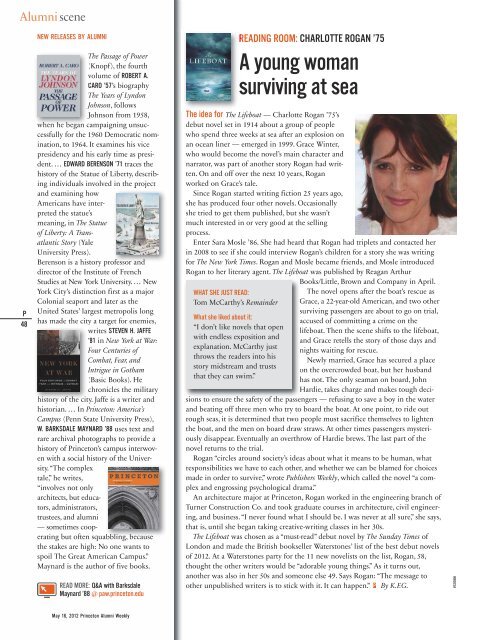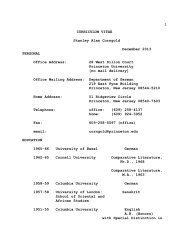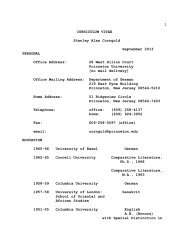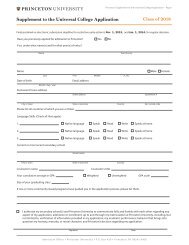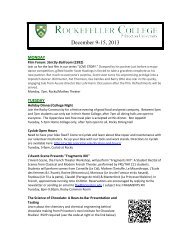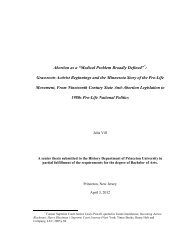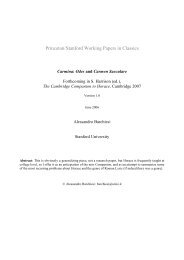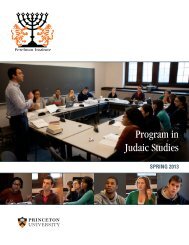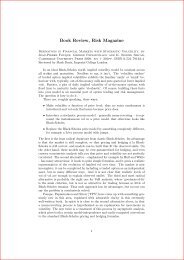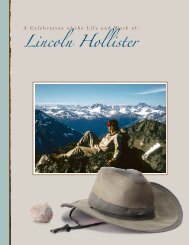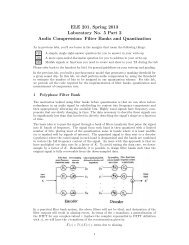Campaign residen the P -litics - Princeton University
Campaign residen the P -litics - Princeton University
Campaign residen the P -litics - Princeton University
You also want an ePaper? Increase the reach of your titles
YUMPU automatically turns print PDFs into web optimized ePapers that Google loves.
Alumni scene<br />
P<br />
48<br />
NEW RELEASES BY ALUMNI READING ROOM: CHARLOTTE ROGAN ’75<br />
The Passage of Power<br />
(Knopf), <strong>the</strong> fourth<br />
volume of ROBERT A.<br />
CARO ’57’s biography<br />
The Years of Lyndon<br />
Johnson, follows<br />
Johnson from 1958,<br />
when he began campaigning unsuccessfully<br />
for <strong>the</strong> 1960 Democratic nomination,<br />
to 1964. It examines his vice<br />
p<strong>residen</strong>cy and his early time as p<strong>residen</strong>t.<br />
... EDWARD BERENSON ’71 traces <strong>the</strong><br />
history of <strong>the</strong> Statue of Liberty, describing<br />
individuals involved in <strong>the</strong> project<br />
and examining how<br />
Ameri cans have interpreted<br />
<strong>the</strong> statue’s<br />
meaning, in The Statue<br />
of Liberty: A Trans -<br />
atlantic Story (Yale<br />
<strong>University</strong> Press).<br />
Beren son is a history professor and<br />
director of <strong>the</strong> Institute of French<br />
Studies at New York <strong>University</strong>. ... New<br />
York City’s distinction first as a major<br />
Colonial seaport and later as <strong>the</strong><br />
United States’ largest metropolis long<br />
has made <strong>the</strong> city a target for enemies,<br />
writes STEVEN H. JAFFE<br />
’81 in New York at War:<br />
Four Centuries of<br />
Combat, Fear, and<br />
Intrigue in Gotham<br />
(Basic Books). He<br />
chronicles <strong>the</strong> military<br />
history of <strong>the</strong> city. Jaffe is a writer and<br />
historian. ... In <strong>Princeton</strong>: America’s<br />
Campus (Penn State <strong>University</strong> Press),<br />
W. BARKSDALE MAYNARD ’88 uses text and<br />
rare archival photographs to provide a<br />
history of <strong>Princeton</strong>’s campus interwoven<br />
with a social history of <strong>the</strong> Univer -<br />
sity. “The complex<br />
tale,” he writes,<br />
“involves not only<br />
architects, but educators,<br />
administrators,<br />
trustees, and alumni<br />
— sometimes cooperating<br />
but often squabbling, because<br />
<strong>the</strong> stakes are high: No one wants to<br />
spoil The Great American Campus.”<br />
Maynard is <strong>the</strong> author of five books.<br />
READ MORE: Q&A with Barksdale<br />
Maynard ’88 @ paw.princeton.edu<br />
May 16, 2012 <strong>Princeton</strong> Alumni Weekly<br />
The idea for<br />
The Lifeboat — Charlotte Rogan ’75’s<br />
debut novel set in 1914 about a group of people<br />
who spend three weeks at sea after an explosion on<br />
an ocean liner — emerged in 1999. Grace Winter,<br />
who would become <strong>the</strong> novel’s main character and<br />
narrator, was part of ano<strong>the</strong>r story Rogan had written.<br />
On and off over <strong>the</strong> next 10 years, Rogan<br />
worked on Grace’s tale.<br />
Since Rogan started writing fiction 25 years ago,<br />
she has produced four o<strong>the</strong>r novels. Occasionally<br />
she tried to get <strong>the</strong>m published, but she wasn’t<br />
much interested in or very good at <strong>the</strong> selling<br />
process.<br />
Enter Sara Mosle ’86. She had heard that Rogan had triplets and contacted her<br />
in 2008 to see if she could interview Rogan’s children for a story she was writing<br />
for The New York Times. Rogan and Mosle became friends, and Mosle introduced<br />
Rogan to her literary agent. The Lifeboat was published by Reagan Arthur<br />
Books/Little, Brown and Company in April.<br />
WHAT SHE JUST READ:<br />
Tom McCarthy’s Remainder<br />
Ayoungwoman<br />
surviving at sea<br />
What she liked about it:<br />
“I don’t like novels that open<br />
with endless exposition and<br />
explanation. McCarthy just<br />
throws <strong>the</strong> readers into his<br />
story midstream and trusts<br />
that <strong>the</strong>y can swim.”<br />
The novel opens after <strong>the</strong> boat’s rescue as<br />
Grace, a 22-year-old American, and two o<strong>the</strong>r<br />
surviving passengers are about to go on trial,<br />
accused of committing a crime on <strong>the</strong><br />
lifeboat. Then <strong>the</strong> scene shifts to <strong>the</strong> lifeboat,<br />
and Grace retells <strong>the</strong> story of those days and<br />
nights waiting for rescue.<br />
Newly married, Grace has secured a place<br />
on <strong>the</strong> overcrowded boat, but her husband<br />
has not. The only seaman on board, John<br />
Hardie, takes charge and makes tough deci-<br />
sions to ensure <strong>the</strong> safety of <strong>the</strong> passengers — refusing to save a boy in <strong>the</strong> water<br />
and beating off three men who try to board <strong>the</strong> boat. At one point, to ride out<br />
rough seas, it is determined that two people must sacrifice <strong>the</strong>mselves to lighten<br />
<strong>the</strong> boat, and <strong>the</strong> men on board draw straws. At o<strong>the</strong>r times passengers mysteriously<br />
disappear. Eventually an overthrow of Hardie brews. The last part of <strong>the</strong><br />
novel returns to <strong>the</strong> trial.<br />
Rogan “circles around society’s ideas about what it means to be human, what<br />
responsibilities we have to each o<strong>the</strong>r, and whe<strong>the</strong>r we can be blamed for choices<br />
made in order to survive,” wrote Publishers Weekly, which called <strong>the</strong> novel “a complex<br />
and engrossing psychological drama.”<br />
An architecture major at <strong>Princeton</strong>, Rogan worked in <strong>the</strong> engineering branch of<br />
Turner Construction Co. and took graduate courses in architecture, civil engineering,<br />
and business. “I never found what I should be. I was never at all sure,” she says,<br />
that is, until she began taking creative-writing classes in her 30s.<br />
The Lifeboat was chosen as a “must-read” debut novel by The Sunday Times of<br />
London and made <strong>the</strong> British bookseller Waterstones’ list of <strong>the</strong> best debut novels<br />
of 2012. At a Waterstones party for <strong>the</strong> 11 new novelists on <strong>the</strong> list, Rogan, 58,<br />
thought <strong>the</strong> o<strong>the</strong>r writers would be “adorable young things.” As it turns out,<br />
ano<strong>the</strong>r was also in her 50s and someone else 49. Says Rogan: “The message to<br />
o<strong>the</strong>r unpublished writers is to stick with it. It can happen.” π By K.F.G.<br />
HBGUSA


